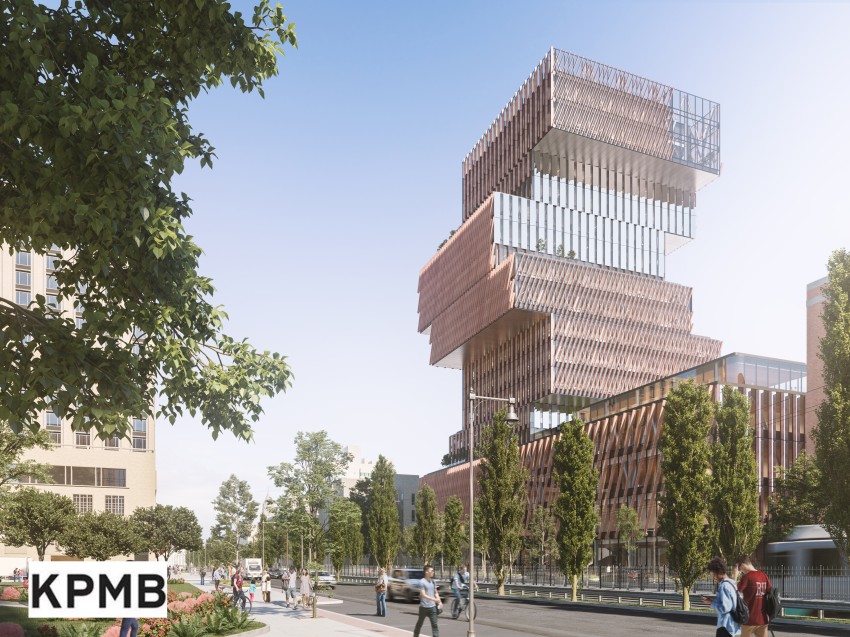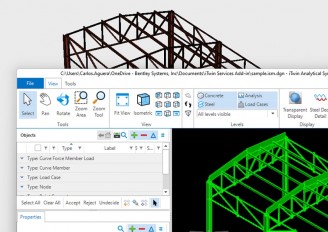Foundations challenges and solution for the Boston University Center for Computer & Data Sciences project Featured

With its unique, award-winning, design resembling a cantilevered stack of books, the Center for Computing & Data Sciences is a striking addition to Boston University’s Central Campus which is located along the banks of the Charles River. The 19-story structure’s theme of “collaboration” was projected in specialty geotechnical contractor Keller being brought on board early in the design planning stages to provide technical and constructability guidance for the foundation work. Subsequently, Keller’s project experience history in the Boston area and the ability to field a highly skilled workforce was instrumental in the company being retained for installation of the final design.
The 19-story building’s concrete mat foundation required excavation to depths ranging from approximately 25 ft at the podium to 42 ft at the “stacked book” tower. Subsurface conditions generally consisted of glacial fluvial sand and marine clay deposits located below a shallow groundwater table. Keller’s work included:
- Installation of a driven steel sheet pile temporary earth retention system.
- Jet grouting to achieve closure where an active utility passed through the earth retention system.
- Installation of several deep foundation techniques – including drilled micropiles, driven steel friction piles, steel H-piles, and helical piles –to meet a variety of technical and constructability challenges.
The challenge
Several challenges needed to be overcome over the course of the project:
- Since foundation work began early in the 2020 COVID-19 pandemic, strict on-site health and safety protocols were required.
- Existing foundations and utilities adjacent to the site precluded the use of anchors as a means of lateral support.
- A critical telecommunications utility that could not be relocated crossed the earth retention in two places, interrupting continuity of the interlocked sheet pile support system.
The solution
Team collaboration and communication was particularly critical given the COVID landscape which included a delayed project start-up and implementation of many on-site safety adjustments associated with a University Campus in an urban city environment.
Temporary Earth Retention
After careful review of a range of options, including considerations for costs, performance, and potential impacts to adjacent structures and utilities, the project team opted for an internally braced, driven sheet pile temporary earth retention system. Three levels of bracing were required at the tower end of the site and one at the podium.
An important factor in the selected earth retention was its ability to accommodate an existing telecommunications utility that bisected the earth retention alignment. This utility could not be relocated, and thus prevented closure of the driven sheet pile system at two locations. To resolve this design challenge, jet grouting was incorporated to achieve closure. The irregular “scalloped” face of the jet grout columns was trimmed to provide a flat substrate for bracing installation. The critical utility was suspended inside the temporary sheeting before excavation continued below.
Deep Foundations
Deep foundation techniques included micropiles, H-piles, and helical piles. Drilled micropiles were installed in the shallower podium section of the building to provide uplift resistance against potential hydrostatic pressure which was factored for flood resiliency. Driven steel friction piles were installed to support temporary shoring towers required due to the building’s cantilevered design. End-bearing steel H-piles were driven to bear in the deep glacial till and bedrock to support the tower crane. Finally, an economical helical pile deep foundation solution was selected to provide support and uplift anchorage for retaining walls and a bicycle canopy structure.
Learn more about KELLER North America Deep Foundations solutions
Source: Boston University Center for Computer & Data Sciences
Want to read more like this story?

Support of excavation and deep foundations for a multi-use building
Apr, 17, 2024 | NewsWhen subjected to wet and dry cycles, the claystone bedrock exhibited expansion and contraction, be...

Keller performs its first O-pile project in Canada
Feb, 10, 2021 | NewsKeller, world’s leader in geotechnical solutions, announces the completion of its first interlockin...

Case History - Renovation of the historic Richmond Train Station 21
Aug, 23, 2016 | NewsBACKGROUND Built in 1901, the historic train station is located in Downtown Richmond. The city is r...

Maine Medical Center
Nov, 22, 2024 | NewsMaine Medical Center is northern New England’s largest hospital and a leading heart care, orthopedi...

The Transformation of New England's Maine Medical Center
Jul, 19, 2022 | NewsAs a highly complex project located at a sensitive site draws to a close, Business Development Exec...

Petrochemical Sump and Pipe Support by Hayward Baker
Sep, 06, 2019 | NewsHayward Baker worked on a sheet pile & helical pile installation in restricted access conditions...

Keller reaches new depths
Oct, 31, 2024 | NewsIt’s a place Keller knows incredibly well, having been involved in virtually every building develop...

Keller brings expertise and environmental innovation to Norway hospital project
Aug, 11, 2021 | NewsIt’s a complex project. The new buildings will be right in the heart of the campus, linked to exist...

Aurum Road Wildlife Crossing Project
Feb, 12, 2024 | NewsKeller North America provided slope stabilization and deep foundations solutions for culvert constr...
Form
Looking for more information? Fill in the form and we will contact Keller for you.
Trending

Spectacular interchanges around the world

New Release - STAAD.Pro 2024 - 2

ADINA 2025 for Structural WorkSuite

ADINA 2025 New Release!

Concrete Buildings as Rechargeable Batteries

Powerful earthquake shakes central Philippines, dozens killed


